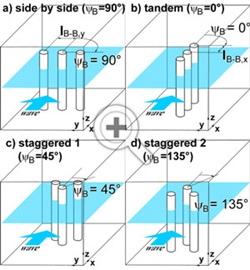 Basic arrangements of large roughness elements in CFD tests
Basic arrangements of large roughness elements in CFD tests Storm surges following Hurricane Katrina, as well as the devastating tsunamis in the Indian Ocean and Japan’s Pacific coast, have increased public awareness of disastrous floods in urban settings. To help improve risk assessments, we are developing an alternative approach that takes urban structures into account in flood modelling.
To do this, we must be able to assess the potential impact of events like these. Accurate estimates of flood potential and inundation are essential to properly protect vulnerable regions and ultimately reduce losses of life and property.
In urban areas however, small-scale topographic patterns of houses and vegetation (large roughness elements) complicate these estimates. Usually, these large roughness elements are not resolved in model grids. Additionally, their flow resistance is not well understood. As a result, flood inundation modelling in cities can be uncertain and imprecise.
In order to adequately account for urban structures and vegetation, highly detailed 3D Computational Fluid Dynamics (CFD) modelling is required, which is not feasible at real scale. It also necessitates high resolution and up-to-date geospatial data of the city. These are expensive to generate and are not available for all cities. This is one reason why modellers often rely on simplifying assumptions.
 Configuration of groups of roughness elements in CFD tests
Configuration of groups of roughness elements in CFD tests Currently, it is common practice to use depth-averaged models like MIKE 21. Such models can account for the bottom surface roughness by a quadratic friction law. However, the models are usually built up in a resolution, which is too coarse to represent buildings and vegetation. Therefore, modellers have to artificially increase roughness coefficients to account for these roughness elements.
In cooperation with the Department of Hydromechanics and Coastal Engineering of Leichtweiss-Institute for Hydraulic Engineering and Water Resources of Technische Universität Braunschweig in Germany, we are developing prediction formulae for the hydraulic resistance of different large roughness elements. These can then subsequently be implemented in existing
models like MIKE 21. This will result in better preparedness and flood protection,
as well as a reduction in losses following floods.
For further information please refer to Leschka & Oumeraci (2011)